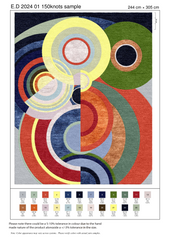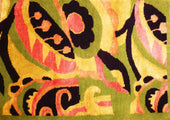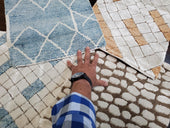Discover the Uniqueness of Moroccan Rugs
Introduction to Moroccan Rugs
Moroccan rugs have a long history and cultural significance. They are more than just decor. Handmade by skilled artisans, these rugs carry the essence of tradition, creativity, and craftsmanship. Whether you are decorating a modern home or a more traditional space, Moroccan rugs add a unique touch to any room.
In this article, we will explore what makes Moroccan rugs so special. We’ll also discuss why they have become increasingly popular and how they stand out from other types of rugs.
The History and Origins of Moroccan Rugs
Moroccan rugs have been made for centuries by the Berber tribes of North Africa. The Berbers, native to Morocco, are known for their weaving traditions. The designs of these rugs are not only beautiful but also meaningful. Each pattern tells a story or conveys a message that has been passed down through generations.
Historically, Moroccan rugs were used for practical purposes. Berber tribes used them for warmth during cold winters and as floor coverings for their homes. Today, they have evolved into highly sought-after pieces of art and decor.
What Makes Moroccan Rugs Unique?
There are many factors that make Moroccan rugs stand out:
- Handmade Craftsmanship: Moroccan rugs are handwoven by skilled artisans. Each rug takes weeks or even months to complete. This level of care ensures every rug is one-of-a-kind.
- Natural Materials: Most Moroccan rugs are made from natural fibers like wool. Wool provides warmth, softness, and durability, making these rugs both functional and comfortable.
- Unique Designs: Moroccan rugs often feature bold geometric patterns, symbols, and motifs. These designs vary by region and tribe, making each rug unique.
- Cultural Significance: The designs in Moroccan rugs are often inspired by the weaver’s surroundings, beliefs, and experiences. This deep connection to culture adds emotional value to the rug.
My Personal Experience with Moroccan Rugs
I have owned a Moroccan rug for several years, and it has truly transformed my living space. The natural wool feels soft underfoot, and the intricate design adds character to my home. What stands out to me the most is its durability. Despite high foot traffic, my Moroccan rug has maintained its quality and appearance.
One of the advantages of owning a Moroccan rug is its versatility. I can move it from room to room, and it fits seamlessly with different styles of decor. Whether in the living room or bedroom, it adds warmth and charm to the space.
The Benefits of Wool in Moroccan Rugs
Moroccan rugs are often made from wool, a natural material with many benefits:
- Durability: Wool is known for its long-lasting nature. Moroccan rugs made from wool can withstand years of use without losing their beauty.
- Softness: Wool is soft and feels comfortable underfoot, making it perfect for rooms where you want a cozy atmosphere.
- Insulation: Wool naturally helps insulate the home. In cold weather, a wool rug can help keep your living space warm.
- Eco-Friendly: Wool is a renewable resource, making it an environmentally friendly option.
Alternatives to Wool in Rugs
While wool is the most common material for Moroccan rugs, there are other options if you're looking for a substitute:
- Cotton: Cotton rugs are lightweight and easy to clean. They are great for rooms with lighter foot traffic and can offer a softer look compared to wool.
- Jute: Jute rugs have a more rustic feel. They are made from plant fibers and are eco-friendly. However, they are less soft than wool rugs.
- Synthetic Materials: While less authentic, some Moroccan-style rugs are made from synthetic fibers like polyester. These are often more affordable but lack the natural benefits of wool.
How to Care for Your Moroccan Rug
Taking care of your Moroccan rug ensures it will last for generations. Here are a few tips:
- Regular Cleaning: Vacuum your rug regularly to remove dust and dirt. Be gentle to avoid damaging the fibers.
- Spot Cleaning: If a spill occurs, clean it immediately with a damp cloth. Avoid using harsh chemicals as they can harm the natural fibers.
- Rotate the Rug: Rotate your rug every few months to ensure even wear and tear.
- Professional Cleaning: Once a year, have your Moroccan rug professionally cleaned to maintain its quality.
FAQs about Moroccan Rugs
What makes Moroccan rugs different from other rugs?
Moroccan rugs are unique because of their handmade craftsmanship, bold designs, and cultural significance. Each rug tells a story and adds character to any room.
How long does a Moroccan rug last?
With proper care, a Moroccan wool rug can last for decades or even generations. Wool is a durable material that stands up well to wear and tear.
Are Moroccan rugs expensive?
Moroccan rugs can range in price depending on the size, material, and craftsmanship. Handmade rugs tend to be more expensive, but they are also more durable and unique.
Can I use a Moroccan rug in a high-traffic area?
Yes, Moroccan rugs made from wool are durable and can withstand high-traffic areas like living rooms or hallways.
How do I know if my Moroccan rug is authentic?
Look for signs of handmade craftsmanship, such as slight imperfections and variations in the design. Authentic Moroccan rugs are usually made from natural materials like wool.
Conclusion
Moroccan rugs are more than just floor coverings; they are pieces of art that bring warmth, character, and history to your home. Whether you prefer bold geometric patterns or simple designs, there is a Moroccan rug that will fit your style.
If you're looking to add a unique touch to your home, consider investing in a Moroccan rug. It’s an investment that will last for generations, adding beauty and comfort to your space.
Visit our store today to explore our stunning collection of authentic Moroccan rugs. Find the perfect rug to elevate your home’s style!







